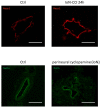Hedging against Neuropathic Pain: Role of Hedgehog Signaling in Pathological Nerve Healing
- PMID: 33266112
- PMCID: PMC7731127
- DOI: 10.3390/ijms21239115
Hedging against Neuropathic Pain: Role of Hedgehog Signaling in Pathological Nerve Healing
Abstract
The peripheral nervous system has important regenerative capacities that regulate and restore peripheral nerve homeostasis. Following peripheral nerve injury, the nerve undergoes a highly regulated degeneration and regeneration process called Wallerian degeneration, where numerous cell populations interact to allow proper nerve healing. Recent studies have evidenced the prominent role of morphogenetic Hedgehog signaling pathway and its main effectors, Sonic Hedgehog (SHH) and Desert Hedgehog (DHH) in the regenerative drive following nerve injury. Furthermore, dysfunctional regeneration and/or dysfunctional Hedgehog signaling participate in the development of chronic neuropathic pain that sometimes accompanies nerve healing in the clinical context. Understanding the implications of this key signaling pathway could provide exciting new perspectives for future research on peripheral nerve healing.
Keywords: desert hedgehog; nerve healing; neuropathic pain; peripheral nerve injury; sonic hedgehog.
Conflict of interest statement
The authors declare no conflict of interest.
Figures




Similar articles
-
Shhedding New Light on the Role of Hedgehog Signaling in Corneal Wound Healing.Int J Mol Sci. 2022 Mar 26;23(7):3630. doi: 10.3390/ijms23073630. Int J Mol Sci. 2022. PMID: 35408986 Free PMC article. Review.
-
Could an endoneurial endothelial crosstalk between Wnt/β-catenin and Sonic Hedgehog pathways underlie the early disruption of the infra-orbital blood-nerve barrier following chronic constriction injury?Mol Pain. 2017 Jan-Dec;13:1744806917727625. doi: 10.1177/1744806917727625. Mol Pain. 2017. PMID: 28814148 Free PMC article.
-
Early alterations of Hedgehog signaling pathway in vascular endothelial cells after peripheral nerve injury elicit blood-nerve barrier disruption, nerve inflammation, and neuropathic pain development.Pain. 2016 Apr;157(4):827-839. doi: 10.1097/j.pain.0000000000000444. Pain. 2016. PMID: 26655733
-
Desert hedgehog is a mediator of demyelination in compression neuropathies.Exp Neurol. 2015 Sep;271:84-94. doi: 10.1016/j.expneurol.2015.04.014. Epub 2015 May 1. Exp Neurol. 2015. PMID: 25936873
-
[In vivo characterization of sonic hedgehog in the peripheral nerve regeneration].Brain Nerve. 2007 Dec;59(12):1341-6. Brain Nerve. 2007. PMID: 18095483 Review. Japanese.
Cited by
-
Melatonin signalling in Schwann cells during neuroregeneration.Front Cell Dev Biol. 2022 Oct 10;10:999322. doi: 10.3389/fcell.2022.999322. eCollection 2022. Front Cell Dev Biol. 2022. PMID: 36299487 Free PMC article. Review.
-
Shhedding New Light on the Role of Hedgehog Signaling in Corneal Wound Healing.Int J Mol Sci. 2022 Mar 26;23(7):3630. doi: 10.3390/ijms23073630. Int J Mol Sci. 2022. PMID: 35408986 Free PMC article. Review.
-
Advancing Our Understanding of the Chronically Denervated Schwann Cell: A Potential Therapeutic Target?Biomolecules. 2022 Aug 17;12(8):1128. doi: 10.3390/biom12081128. Biomolecules. 2022. PMID: 36009023 Free PMC article. Review.
-
The Primary Cilium and its Hedgehog Signaling in Nociceptors Contribute to Inflammatory and Neuropathic Pain.Res Sq [Preprint]. 2024 Feb 26:rs.3.rs-3812442. doi: 10.21203/rs.3.rs-3812442/v1. Res Sq. 2024. PMID: 38464172 Free PMC article. Preprint.
-
Recent Advances in Biomolecular Patho-Mechanistic Pathways behind the Development and Progression of Diabetic Neuropathy.Biomedicines. 2024 Jun 23;12(7):1390. doi: 10.3390/biomedicines12071390. Biomedicines. 2024. PMID: 39061964 Free PMC article. Review.
References
-
- Arthur-Farraj P.J., Latouche M., Wilton D.K., Quintes S., Chabrol E., Banerjee A., Woodhoo A., Jenkins B., Rahman M., Turmaine M., et al. c-Jun reprograms Schwann cells of injured nerves to generate a repair cell essential for regeneration. Neuron. 2012;75:633–647. doi: 10.1016/j.neuron.2012.06.021. - DOI - PMC - PubMed
Publication types
MeSH terms
Substances
LinkOut - more resources
Full Text Sources

